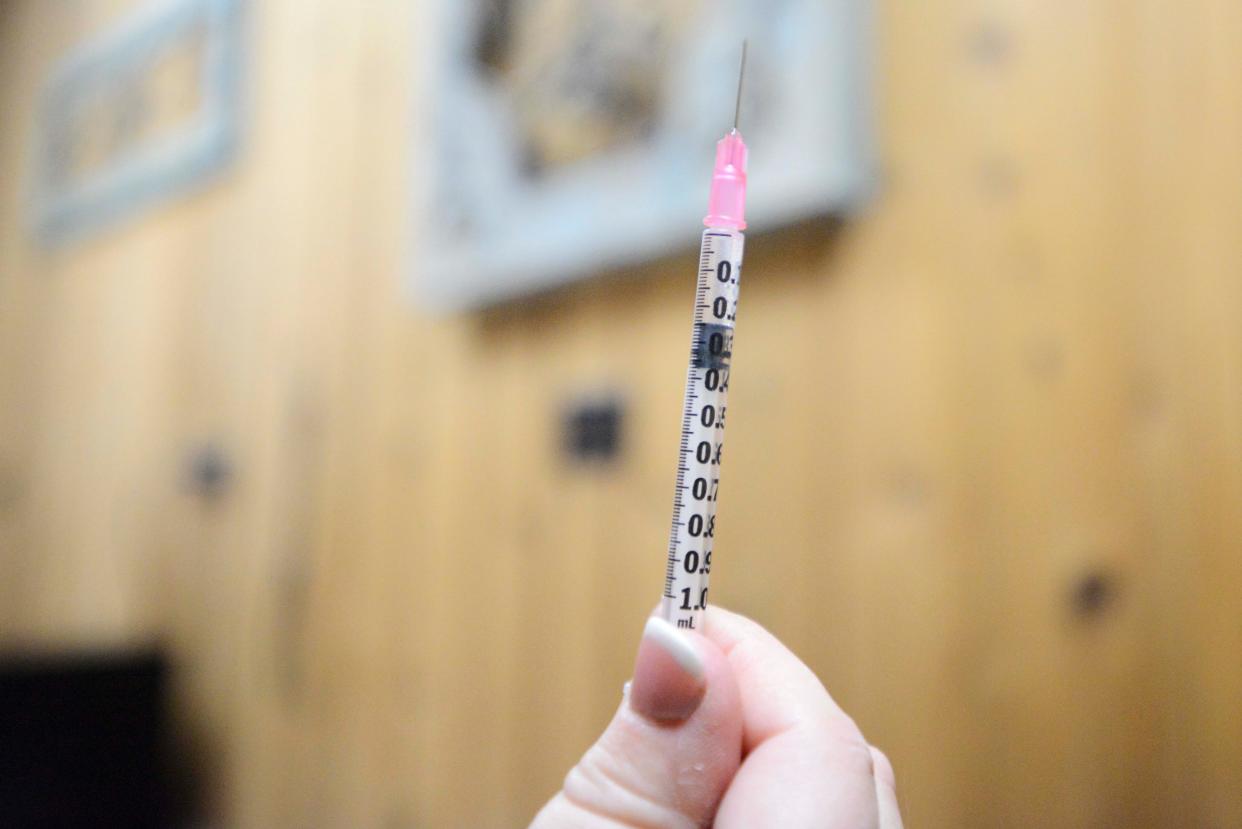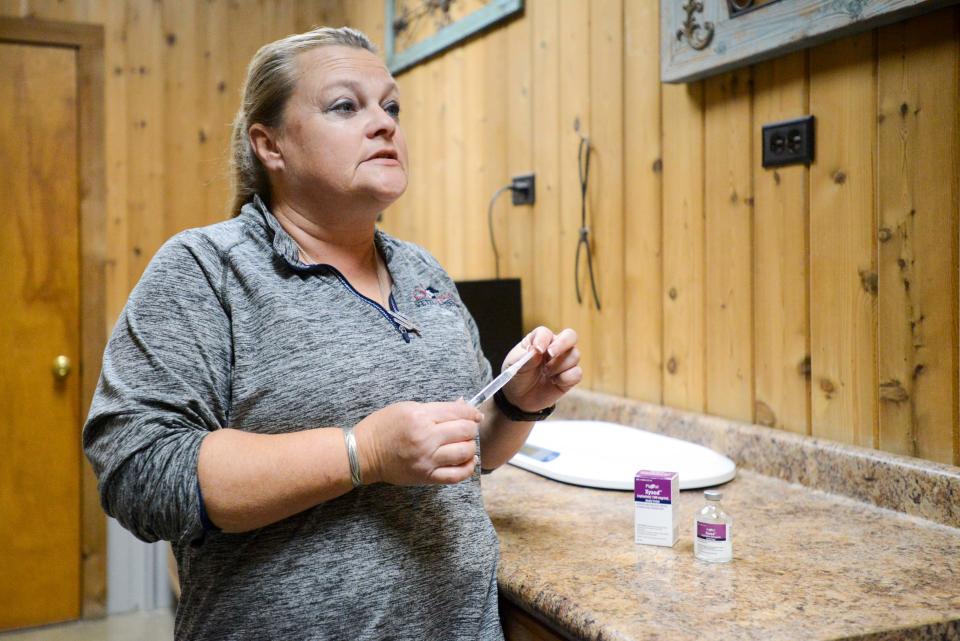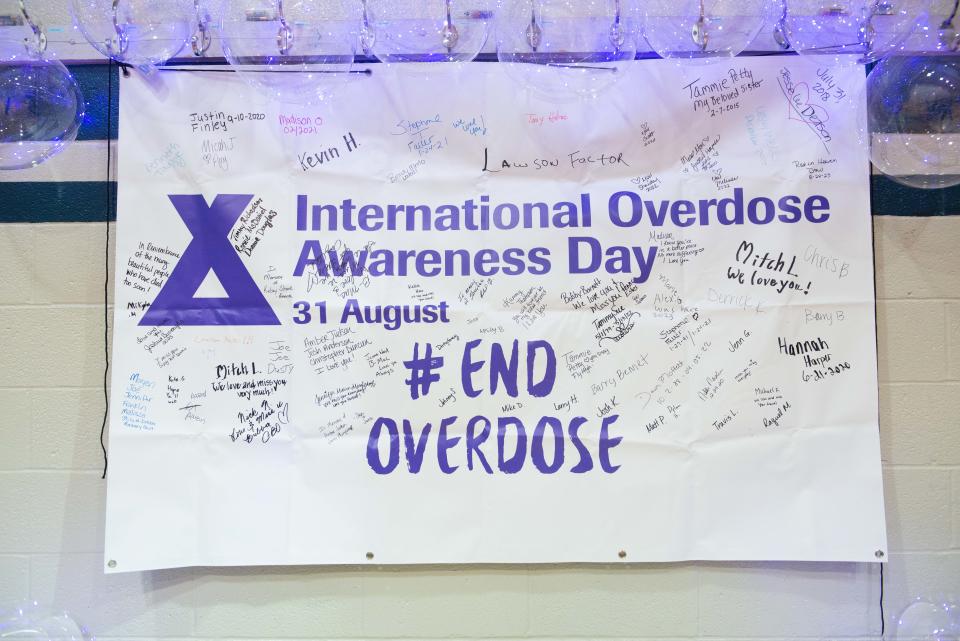War on xylazine: How a horse tranquilizer has entered Tennessee's opioid epidemic

A safe and controlled sedative intended only for large animals like horses is becoming an increasingly popular adulterant to substances like fentanyl, prompting flesh-eating skin ulcerations in humans — earning it the apt slang term "zombie drug."
To the naked eye, xylazine is innocuous.
The colorless, odorless liquid needs but three milliliters to quickly sedate a 1,200-pound horse for a 30-45 minute procedure. This includes routine tasks like sewing lacerations, castrations and pulling teeth.
Xylazine goes by several street names like "tranq", dubbed for its tranquilizing properties in animals, and the "zombie drug" for its seemingly zombie-inducing behavior in humans.
It suppresses one's heart rate, blood pressure and substantially slows brain activity. A Central Nervous System depressant, it triggers the CNS's alpha-2 receptors, inhibiting the release of dopamine and resulting in sedation.
Today, the misuse of the sedative is reflected in the rising rate of its traces found in connection with overdose deaths.
'Xylazine is here': Nashville officials warn of threat from animal sedative in overdoses
An affliction nearly every state is being confronted with, Tennessee is no exception. Emerging first in the eastern region, xylazine has now permeated the entirety of the state.
Created in the 1960s, xylazine was approved by the Federal Drug Administration in 1972 as an animal-safe pharmaceutical.
In 2022, the FDA issued a nationwide warning to healthcare professionals about the exposure of xylazine in illicit substances and its inherent life-threatening side effects.
'Xylazine is here': Nashville officials warn of threat from animal sedative in overdoses
More: Families raise awareness about drug abuse dangers during International Overdose Awareness Day
Unable to detect, consequences can be lethal
Using a dosage conversion of approximately one cubic centimeter (cc) per 400 pounds, a 100-pound deer would need 0.25 mL.
On its own, xylazine does not induce a "high" the same as something like fentanyl, whose potency is 50-100 times greater than that of morphine.
When mixed with opioids like fentanyl, whose effects alone are powerful, tranq is the catalyst in increasing lethality and prolonging a user's high for hours.
"Most people don't even know it's in the supply they are using," Dr. Eno Eyo said.
A family medicine doctor in Nashville, Eyo is a current addiction medicine fellow at Vanderbilt's Division of Infectious Diseases. He is the local expert and one of the leading researchers exploring the impacts of xylazine as an emerging illicit substance.
Regardless of inhalation, intravenous injection or intramuscular injection, those who ingest xylazine are at an acute risk of developing severe, rare skin diseases.
"The use of xylazine is leading to skin infections and necrosis," Eyo said. "Folks that use it by injection, they tend to have this skin infection, and a really bad one."
Such skin infections generally warrant amputation as a means of preventing the spread of necrotic tissue to organs.
Considering the increasing prevalence of its illicit emergence only within the last few years, Eyo shared the challenge in gathering human data and that spreading awareness is pertinent.
"It is out there, but it's hard to know where it is and where it's not," he said.
Most concerning about xylazine's presence in illicit concoctions is its unresponsiveness to naloxone (Narcan), the antidote used in opioid overdose reversals.
Eyo encourages calling for emergency care if an individual responds passively to naloxone.
More: International Overdose Awareness Day recognized in Jackson, community education event
'Significant increase' leads to public health crisis

As every corner of the country continues to combat deadly fentanyl overdoses, xylazine has been simultaneously infiltrating communities. As fentanyl analogs grow in potency, using an adulterant like xylazine only adds fuel to the fire.
A member of law enforcement for nearly 35 years, Tennessee Bureau of Investigation Special Agent Tommy Farmer has spent most of his tenure in the realm of drug enforcement.
He possesses the same concerns as healthcare and EMS personnel concerning xylazine's aversion to Narcan.
"Just when you think you're making some progress and you're saving more [lives] and you're stopping the effects of that overdose, then you get something like xylazine," Farmer said.
"I think that we would have some reverse and we may not be as high as we are now with our overdose trend, our fatal overdose trend, had it not been for something like a xylazine that's coming on and complicating the matter of other life-saving drugs."
In the absence of xylazine, employing Narcan as an overdose reversal has more than a 75% success rate.
Echoing Eyo's notion of xylazine's presence in an opioid unbeknownst to the user, Farmer says many don't find out until it's too late.

"It may mimic the effects of an opioid, the person doesn't know their drug has been cut with something else until really it's too late," he said.
Farmer is a part of Tennessee's Dangerous Drug Task Force (TDDTF), a federally grant-funded operation that trains state and local law enforcement officers in how to respond to hazardous drug scenes.
"We do have significant increase in what we are seeing with xylazine in terms of submissions coming in to the crime lab," Farmer said.
Serving all 95 counties with a central crime laboratory in Nashville, TBI has regional labs in Jackson and Knoxville.
Testing for xylazine is complex, but beginning in 2020, its standard has been added to the crime lab panel.
In 2020, Farmer says only nine samples of xylazine were found when tested.
In 2021, it increased to 12 before skyrocketing to 392 in 2022.
Nearing the end of 2023, the lab had already seen 556 samples.
TBI's Annual Report for 2023 states that it is regularly working with the General Assembly to address the increase of xylazine presence in illicit drugs.
Impeding veterinary practices
For vets like Dr. Ellen Deming who have routinely employed xylazine for its intended use over the last 30 years, the illicit manipulation of its use is frustrating.
Owner of Deming Veterinary Service in Jackson, she says xylazine is a first-line-of-defense-pharmaceutical for veterinary procedures.
"When do the rights of the drug addicts become more important than the rights of the horse owners and the horses?" Deming said.
"We have a very limited number of sedatives and analgesics that we can use in horses. It's very hard to get them passed through the FDA when you're giving them to million-dollar animals like Kentucky Derby winners."
Effective July 1, 2023 in Tennessee, House Bill 1242 imposed a Class A misdemeanor for those who knowingly possess xylazine and a Class C felony for those who manufacture, distribute, or sell it.
The current legislation maintains an exception for veterinarians.
Despite xylazine not being a controlled substance, Deming says the U.S. Drug Enforcement Administration advised her to start handling it as though it is.
This means keeping it in a lockbox that's bolted into the frame of the building and maintaining a log that accounts for its every use.
Deming fears that if the DEA moves to classify xylazine as a controlled substance, her ability to treat animals outside of the walls of her practice will be hindered.
"In California, there is legislation out there trying to get it to where controlled substances like that [xylazine] can not be removed from a brick and mortar building," she said.
As an advocate for the animal, Deming says whether a horse is insured for hundreds of thousands of dollars or not, they all deserve the same level of care.
"Say the highway patrol calls me, and they've had a horse hit on the highway, which happens quite a bit, so if that passes to where I can't take those drugs out of a brick-and-mortar building, then I'm like 'I can't help you, I can't take my drugs out of my building.' And who suffers from that? The animals," she said.
As it stands, there isn't a cost-effective or equally as safe alternative to xylazine that vets can use.
Political officials are implementing legislation and law enforcement is navigating how to combat its presence on the street, all while veterinarians are hoping its accessibility for the intended use in animals remains uninhibited.
"We can't afford to lose it," Deming said.
The conversation about xylazine's newly-discovered illicit use is nuanced and rapidly evolving, but most agree its presence is dangerous and the effects devastating to unsuspecting users.
"The number of novel substances, synthetic drugs that are being developed or being placed to market and the ability for individuals to go out there and seek them out, learn about them, make them and ship them has never, never been more dangerous than it is now," Special Agent Farmer said.
For tips, questions, or stories to share, contact Sarah Best at srbest@gannett.com or by phone at (731) 313-3132.
This article originally appeared on Jackson Sun: How 'zombie drug' illicit use is growing at alarming rate in Tennessee

